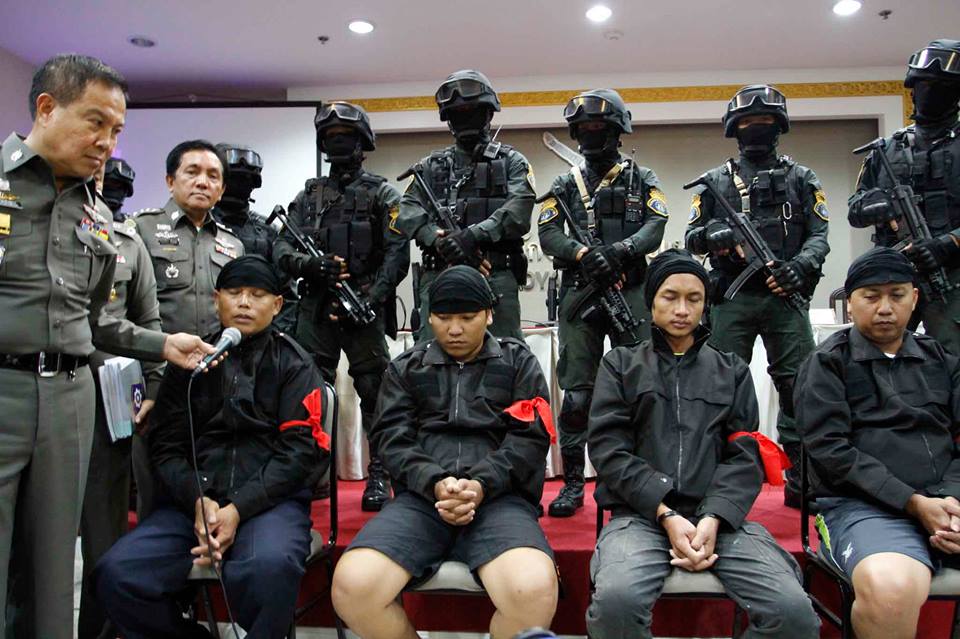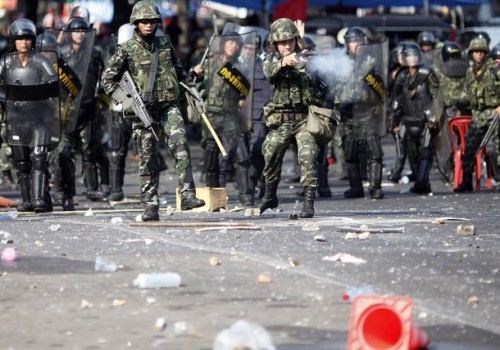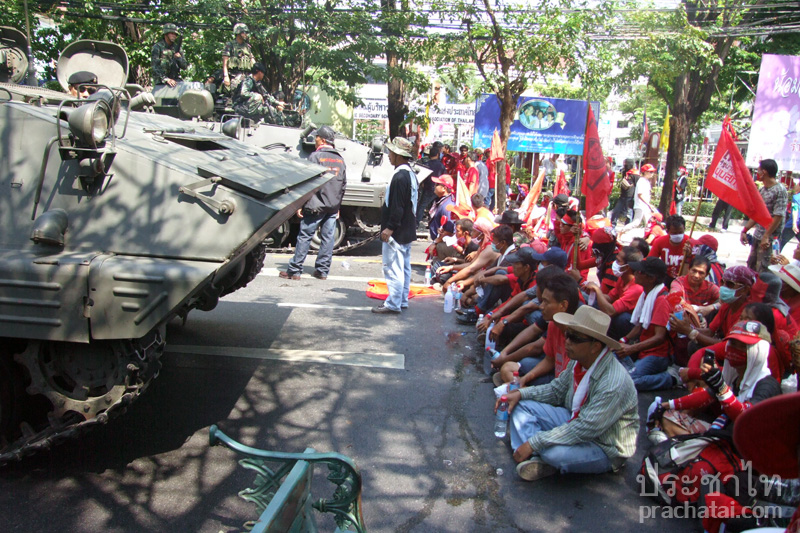2017 marks the 7th anniversary of military operations against red shirt protesters in April 2017. Though many years have passed, justice has yet to come for the dead and injured victims of state-sanctioned political violence.
Redshirts blocked military tanks from reaching their protest camp at Ratchadamnoen Avenue
1. Some interesting numbers
- 3,000 sniper bullets were issued by the military during the operation (only 880 were returned).
- 117,923 bullets were fired during the crackdown.
- The operation’s 25,000 police officers were allocated a budget of 700,000,000 baht.
- The operation’s 67,000 soldiers were allocated a budget of 3,000,000,000 baht.
- A total of 1,283 were injured.
- 1,763 people were arrested and prosecuted for protesting.
- 94 people were killed (88 males and 6 females).
- 10 security officers were killed (3 police and 7 soldiers).
- 2 journalists were killed (a Japanese and an Italian).
- 6 volunteer rescue staff and nurses were killed.
- 32 people were killed by a shot to the head.
- 12 was the youngest victim to be killed.
These figures were provided by People’s Centre for Information on the April – May 2010 Crackdowns (PCI)
2. What was the 10 April Crackdown?
10 April marked the climax of an armed state operation against the United Front for Democracy against Dictatorship (UDD), also known as the red shirts. The operation lasted from 12 March to 19 May 2010. 10 April marked the first day that the operation used violent methods, leading to numerous deaths and injuries.
The Abhisit government launched a “space reclamation” operation with the goal of seizing the red-shirt protest site, from Saphan Phanfa to the Democracy Monument. Many civilians were shot dead by high-velocity bullets. At twilight, a group of “men in black” appeared and fired at the authorities. The total deaths on 10 April was 28 civilians and four authorities, plus one Japanese reporter.
After the crackdown, the UDD protest continued until the government launched its biggest and most violent crackdown between 13 and 19 May, leading to the loss of nearly 70 lives.
3. What were the protesters’ demands?
The UDD demanded that Abhisit Vejjajiva, the PM at the time, dissolve parliament. The Democrat Party-led government had come to power in December 2008 after the Constitutional Court ruled to dissolve the People’s Power Party (PPP), the majority party that led the government. Subsequently, the PM and PPP leader Somchai Wongsawat was impeached.
Domestic and foreign media reported that the military had lobbied small parties and factions of the PPP to vote in the Abhisit government led by the minority Democrat Party. The red shirts, the main supporters of the PPP, claimed that Abhisit had not come to power democratically and as such consistently urged for dissolution of parliament and fresh elections.
In 2009, red shirts gathered at Government House, marking the first protest against the Abhisit administration. The protesters were confronted by the authorities, leading to numerous injuries by gunfire. Despite no official report of deaths, two UDD protesters -- Chaiyaporn Kanthang and Nattapong Poongdee -- disappeared and were later found dead.
4. The lead-up to 10 April
On 24 February 2010, UDD leaders announced a mass protest on 12 March. This announcement was made two days prior to a ruling by the Supreme Court in favour of seizing 4.6 million baht from Thaksin Shinawatra for selling Shin Corporation to the Singaporean Temasek Holdings.
On 9 April, a brief confrontation between redshirts and soldiers took place at the Thaicom Satellite Station in Pathum Thani Province.
The soldiers attempted to block the signal of the People Channel, the television platform the red shirts used to broadcast their protest live. The protesters successfully pushed back the authorities, forcing them to put down their weapons.
A senior journalist Wassana Nanuam observed that the military “felt ashamed that they had to put down their shields, bats and weapons. They were defeated by the protesters which at that time did not have any arms. The weapons were seized and the soldiers were ordered to walk in a line into rice fields.”
A day after, the military reclaimed their “honour” in a ruthless crackdown.

Clash at Thaicom Satellite Station (Photo from Panip)
5. First Blood
It is generally believed that most protesters were killed during the night. In fact, the first casualty occurred in the afternoon of 10 April at Makkhawan Bridge. Kriangkrai Khamnoy, a 23-year-old tuk-tuk driver, was shot dead. In 2014, a court ruled that the bullet came from the security forces. No official has ever been prosecuted.
6. Night-time crackdown
Around 4 pm, a helicopter rained tear gas over Ratchadamnoen Avenue. A protester named Monchai Sae-chong was affected by the tear gas that, according to relatives, aggravated a chronic disease. He died in hospital that night.
The authorities also used rubber bullets against protesters. Though the bullets did not take any lives, they left many injuries, and one protester lost his right eye.
7. 'Men in Black'
The authorities have used the term “men in black” to refer to an armed group alleged to be aligned with the red shirts. In April 2014, the police arrested five people deemed to be men in black. But in October, the group filed a petition with the Office of the Attorney General, asserting that the authorities had tortured them during the investigation process and forced them to plead guilty.
In January 2017,
a court ruled two out of the five guilty of illegally possessing weapons and refused their right to bail. The court also ruled that it did not believe that the five were tortured into pleading guilty. The two convicts face 10-year sentences and have been jailed since September 2014.
Though the court initially ruled the three other suspects innocent, the prosecutor subsequently appealed the case and asked the court to detain the suspects during the appeal process. The court complied and the t
hree were jailed from September 2014 until April 2017.

Police hosting a press conference announcing the arrest of the ‘Men in Black’ (Photo from M Today)
8. Autopsy results
The autopsies on seven bodies concluded that three (Kriangkrai Khamnoy, Charun Chaiman and Sayam Watthanukun) were killed by bullets fired by the authorities. The killers could not be identified. The source of the bullets that killed four other people (Hiroyuki Muramoto, Wasan Phuthong, Thotsachai Mekngamfa and Mana Atchareon) could not be identified.
9. No way to prosecute authorities
On 23 March 2010, Bangkok governor Sukhumbhand Praibatra hosted a “Big Cleaning Day” activity, calling on Bangkokians to clean up the aftermath of the crackdown. The People’s Centre for Information on the April – May 2010 Crackdowns condemned the activity for destroying evidence of state violence.
Though nearly 2,000 protesters were prosecuted after the crackdown, no security officers or government officials involved in the operation have never been punished.
In December 2012, victims and their relatives filed murder charges against Abhisit and Suthep Thaugsuban for their role as directors of the Centre for the Resolution of the Emergency Situation (CRES), the special body responsible for the crackdown.
This was the first case where state officials were indicted for their role in the April political violence. Other cases remain under investigation.
Eventually, the National Anti-Corruption Commission
ruled Abhisit and Suthep not guilty, reasoning that the suspects did not have any intention to harm innocent people. The victims and relatives have appealed the case to the Supreme Court.
No member of the military has ever been prosecuted.

Soldiers firing at protesters (Photo from red BKK)
10. Failed reconciliation efforts
In 2013, the Yingluck government proposed a Political Amnesty Bill to nullify the prosecution of 1,857 people arrested during the crackdown. The bill covered all charges dated between 19 September 2006 and 10 May 2011, including those against the exiled PM Thaksin Shinawatra.
The bill outraged the public as it was seen as an attempt to whitewash Thaksin and the red shirts, regarded by Bangkok people as “Bangkok arsonists”. Even some red shirts denounced the bill as an obstacle to investigations into the people responsible for the crackdown.
The opposition to the bill led to the formation of the People’s Democratic Reform Committee, a protest group led by a former Democrat politician Suthep Thaugsuban. The PDRC was a key factor leading to the 2014 coup, opening the way for the military to rule the country until the present.




